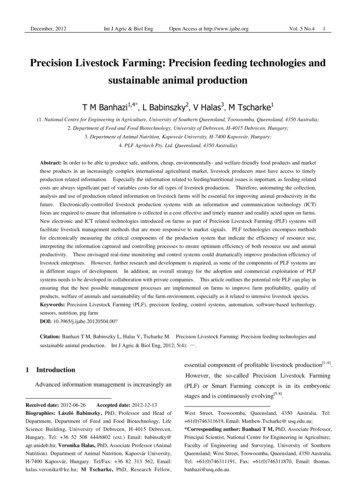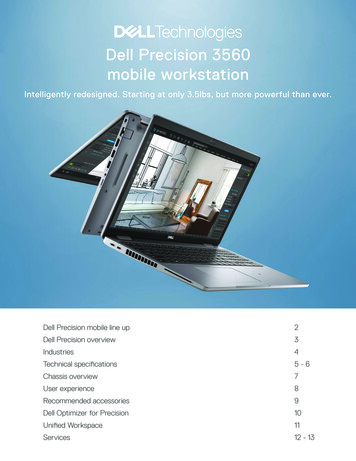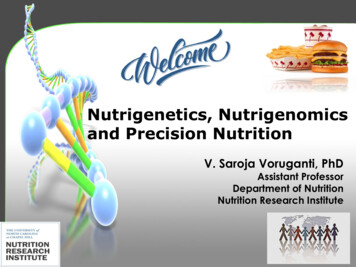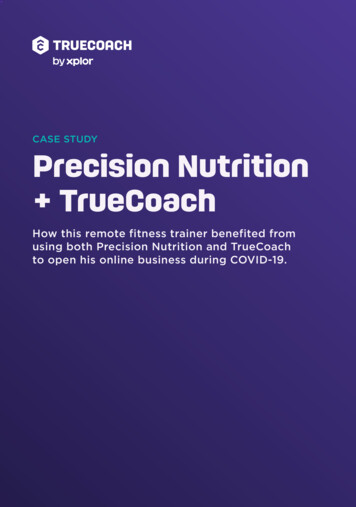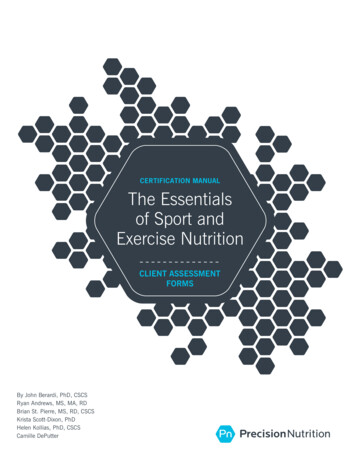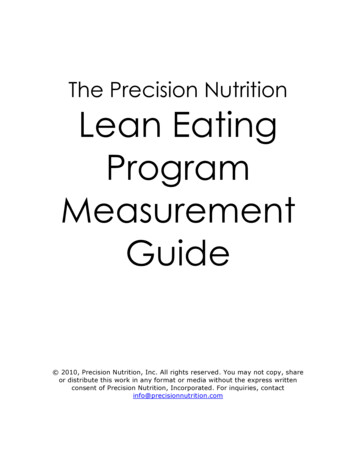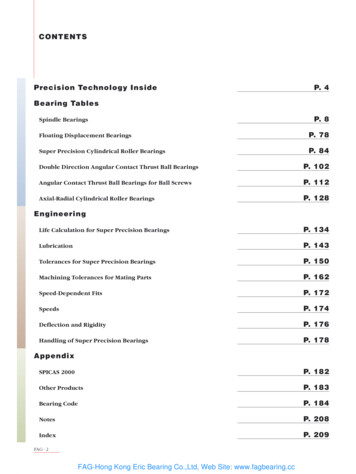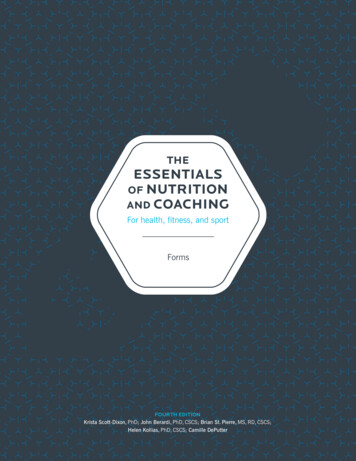
Transcription
THEESSENTIALSOF NUTRITIONAND COACHINGFor health, fitness, and sportFormsFOURTH EDITIONKrista Scott-Dixon, PhD; John Berardi, PhD, CSCS; Brian St. Pierre, MS, RD, CSCS;Helen Kollias, PhD, CSCS; Camille DePutter
Editing: Krista Scott-Dixon, PhD, Rachel Bell, Erin Weiss-Trainor, MScReviewers: Jennifer Broxterman, MSc, RD; Dan Garner, FMP, PNL2; Dr. Trevor Kashey PhD; Dr. Spencer Nadolsky, MD/DO; Dr. Mike T Nelson PhD, MSME, CISSN, CSCS; Irene Pace,RD; Dr. Victor Peña-Araujo, MB, BCh, BAODesign: Carmelo Galati, RGD, Galati Creative Inc.Production art: Carmelo Galati, RGD, Galati Creative Inc.; Caren Thomas, Bus Stop DesignIllustrations: Carmelo Galati, RGD; Alison Dungey, PhD; Kveta; Brendan McNeillPrint: Exodus Graphics Corp.Copyright 2019 by Precision NutritionPrinted 2019All rights reserved. No part of this book may be reproduced or transmittedin any form or by any means, electronic or mechanical, includingphotocopying, recording, or by any information storage and retrievalsystem, without written permission from the publisher.Published by Precision Nutrition, Inc.www.precisionnutrition.com
PRECISION NUTRITION FORMS IntroductionWhen to use the formsOutcome-baseddecision making.It’s at the heart of everything you do as a coach.1. You gather data.2. You analyze it.3. You decide what to do next, based on the evidence.As the saying goes:“If you’re not assessing, you’re guessing.”Indeed, the best coaches are always gathering, analyzing, and using data to make informed,outcome-based decisions.However, sometimes all that data can feel overwhelming.Each client comes to you with: different life experiences and a different personality; different wants and needs; different health conditions, movement capacities, and eating habits; different problem-solving abilities; and different attitudes about change and trying new things.As a coach, you need to triage — to understand what’s most important, right now, for eachunique client. Triaging helps you focus on “first things first” and set the right priorities.But how do you know: What information to gather? And when? What questions to ask? And how? The right way to discuss assessment and analysis with clients? How to walk them through the process step by step?Simple.We’ve already done the work for you.The assessment forms in this package will help you get to know your client better, and helpyou make better, evidence-based decisions about your coaching strategy.Using them, you’ll learn more about your client’s: Physiological indicatorsThis includes blood work, other lab tests, digestive function, and immunity
PRECISION NUTRITION FORMS IntroductionWhen to use the forms Body composition and measurementsThis includes height, weight, body girths, lean mass, and body fat Other health needsThis includes known allergies or food intolerances, medication use, other health problems,and the other health care providers they work with Function and physical capabilityThis includes mobility, daily-life tasks, and athletic performance Psychological state and mindsetThis includes readiness for change, resilience, and problem solving Environment and lifestyleThis includes social support, family, work hours and demands, and travel Goals and desired outcomesThis includes a specific goal weight or body composition change, decreased medicationusage, improved performance measures, and improved relationship with foodBuild your “coaching information database” by using these tools and techniques. And use itto generate strategic plans that your clients can stick with, and that you can feel good about.START WITH THE BASICS.We suggest you begin with The PN Initial Assessment and Triage Questionnaire, which covers: The client’s perspectiveThis includes expectations, goals, self-identified limiting factors, willingness to change, andwhat behaviors they’d like to focus on or change. Social factorsThis includes social support, stress, and relationships. Health indicators and conditionsThis includes injuries, medication use, and digestion. Lifestyle factorsThis includes how often they see the doctor, whether they smoke, how they spend theirtime, and how their kitchen is set up.Ask the client to fill it out beforehand if possible and bring it to your first session together.Filling out forms in advance gives them time to think and remember details.At that first session, discuss their responses with them. Look for more information, and try tounderstand their situation as much as you can. Going through the forms together gives youboth an opportunity to fill in any gaps and make sure you’re both on the same page.A good initial assessment helps you match your coaching plan to what the client can actuallyunderstand, manage, and do. This ensures that your clients go steadily from success tosuccess, rather than swinging wildly from resistance to anxiety to failure.The initial assessment also helps you to give clients an objective appraisal of what and howthey’re doing, helps you identify clients who are at risk for illness and / or injury, and helpsyou determine if you need to refer a client out, either because they fall outside your scopeof practice or because the relationship would be a mismatch (remember, referring out is animportant and valuable option).
PRECISION NUTRITION FORMS IntroductionWhen to use the formsAfter the first session, if you feel like the Initial Assessment and Triage Questionnaire raisessome additional questions you’d like to answer immediately, use some of the questionnairesand worksheets included here. These may help you: identify what’s most important to your client right now; learn what “progress” means for your client; identify specific ways to track progress with your client; collaborate on next actions together; ensure that your client is able to execute any tasks you give them; and / or focus on a particular area of interest, such as past / current health problems, sportnutrition, readiness for change, planning and time useKeep in mind: You don’t have to use all of these. We recommend you only try one at a time. Feel free to use them throughout the entire coaching process. Only use a form if you find it useful when making coaching decisions.COACH AND CLIENT FORMSMany of the forms have “coach” and “client” versions.CThe “coach version” is like a teacher’s guide to a classroom textbook. It explainswhat the form is used for, how to talk about the form with your clients, and whyyou might ask for certain types of information from your clients. Coach versionshave the symbol C.The “client version” is what your clients will see. Simple, to the point, only asking what’sneeded for each topic. You can give these to your client to fill out at home and bring toyour sessions.We suggest you review the “coach version” of each form before handing the “client” versionout. This will help you feel ready and able to explain each form. This will, in turn, help yourclients better understand what you’re hoping to accomplish and “buy in” to the process.
PRECISION NUTRITION FORMS IntroductionWhen to use the formsIndex of Precision Nutrition formsHere’s a list of all the worksheets, assessments and questionnaires contained in thispackage, including what each is used for.Worksheets, assessments, and questionnairesWORKSHEET,ASSESSMENT,OR QUESTIONNAIREWHAT IT’S USED FORVERSIONSPN Initial Assessmentand TriageQuestionnaireHelps you match your coaching plan to what the client canactually understand, manage, and do. Also helps you to giveclients an objective appraisal of what and how they’re doing,helps you identify clients who are at risk for illness and/or injury,and helps you determine if you need to refer a client out.Coach version24 Crazy QuestionsWorksheetFor helping clients think through the benefits of the status quoand what they’ll have to give up to change.Client versionA-B-C WorksheetSimilar to the red-yellow-green light food list, use for negotiatingwhich specific exercises and/or foods clients can / will do or eat.(At least right now.)Client versionAll-or-None WorksheetFor helping clients see choices as a continuum versus all ornothing.Client versionAthletic NutritionNeeds QuestionnaireFor understanding a client’s training goals, training volume,current recovery practices, and current nutrition practices.Client versionBehavior AwarenessWorksheetFor helping clients change unwanted habits and behaviors (suchas stress eating).Client versionBody MeasurementsFormFor tracking body composition in clients who might benefit fromregular measures.Client versionEating HabitsQuestionnaireFor learning more about a client’s eating patterns.Coach versionClient version3Client versionFOOD JOURNALS3-Day Diet RecordFor recording exactly what a client is eating.Client version80% Full MealJournalFor helping clients learn how to eat until satisfied versus stuffedand tracking progress in this area.Client version1 Coach versions contain scripts or background information that that you can use to either explain the form to yourclients, or to understand why we’ve asked certain questions. It’s like a “Teacher’s guide” for school teachers.2 Client versions of forms are for the clients to take home and fill out themselves.
PRECISION NUTRITION FORMS IntroductionWORKSHEET,ASSESSMENT,OR QUESTIONNAIREWhen to use the formsWHAT IT’S USED FORVERSIONSAthletic PerformanceIndicators andAthleteNutrition JournalFor correlating mood, energy, and motivation with dietaryintake in hard-training athletes. Includes Athletic PerformanceIndicators worksheet.Client versionEating BehaviorsJournalFor capturing a client’s urges, cravings, and behaviors aroundmeals.Client versionEating Slowly MealJournal and MealDuration JournalFor tracking a client’s meal speed and whether they’reClient versionEmotional EatingJournalFor capturing a client’s emotions and thoughts and how theymight lead to different food choices.Client versionHow Food FeelsJournalFor capturing a client’s physical sensations (like allergies orintolerances) related to food.Client versionHand-SizePortion GuideA simple guide to calorie control without calorie tracking.Coach versionIdeas for MovementSuggestions for daily movement outside of scheduled “exercise”.consistently eating slowly and mindfully. Use Eating Slowly forsubjective self-assessment or Meal Duration for objective selfassessment.Client versionCoach versionClient versionKitchen Set-upAssessmentFor helping highlight the relationship between a client’senvironment and their food habits.Coach versionLimiting Factors,Advantages, andBehavior Goals LogFor identifying a client’s struggles, their advantages, and how toturn them into a plan for change.Coach versionMake It A HabitWorksheetFor moving from vague idea or outcome goal to specific habitand behavior goal.Coach versionMeal ConsistencyWorksheetFor tracking a client’s consistency with agreed-upon behaviorsand practices.Coach versionClient versionClient version
PRECISION NUTRITION FORMS IntroductionWhen to use the forms1WORKSHEET,ASSESSMENT,OR QUESTIONNAIREWHAT IT’S USED FORVERSIONSMedical Historyand PresentMedical ConditionQuestionnaire4Provides more detailed information about the client’soverall health.Coach versionPlanning and TimeUse WorksheetFor clients who have problems with time management.Client versionPrecision NutritionPlateA simple way to structure each meal the Precision Nutrition way.Client versionPush-Pull-HabitAnxiety WorksheetFor identifying what’s pushing clients away from old ways ofdoing things and pulling them towards new things.Client versionReady, Willing, andAble WorksheetFor helping establish how ready, willing, and able a client is tomake a given change. Also helps coaches “shrink the change” tomake it more manageable.Client versionSleep and RecoveryIdeasFor helping coaches discuss sleep rituals and stressmanagement.Coach versionSocial Support FormFor showing how social support influences a client’s eating andmovement decisions.Coach versionSphere of ControlWorksheetFor helping clients identify what they have control over and don’t to better manage stress and expectations.Coach versionStress and RecoveryQuestionnaireFor showing patterns of sleep, stress, and recovery.Coach versionThe Hunger GameFor helping clients better tune into hunger and appetite cues.Client versionWant-Willing-Won’tWorksheetFor negotiating what clients want, and what they’re willing to do(or not do) for that goal right now.Coach versionClient versionClient versionClient versionClient versionClient version1 Remember that Medical Nutrition Therapy is off limits unless you’re a registered dietitian. We include this form soyou can have access to the client’s medical history in case that needs to inform your advice.Client version
PRECISION NUTRITION FORMS IntroductionWhen to use the formsUsing The Precision Nutrition FormsHere’s how to choose which form to use when.Session 1:Initial Assessmentand Triage FormEnough data for now?YNMove to exploring,understanding andworking with existingstrengths, limitingfactors, and highimpact skills.Use appropriateassessment forms;collect only the datayou needBodycomposition orweight changegoalPast or currenthealth problemsMedical History & PresentMedical ConditionAthletic / sportsnutritionAthletic Nutrition NeedsAthletic Nutrition JournalReadiness forchangeReady, Willing, AbleA-B-CWant-Willing-Won'tQuality of eatinghabitsHOW TO GET THE MOST OUT OF OUR ASSESSMENT FORMSBody MeasurementsStep 1: Eating HabitsStep 2: How Food Feels;Behavior Awareness;Meal ConsistencyStep 3: 3-day dietary recordPlanningand time usePlanning & Time UseSphere of ControlWant-Willing-Won’tSocial supportand householdSocial SupportKitchen Set-upStress andrecoverySleep & RecoverySphere of ControlPlanning & Time UseKeep it simple.Use as few forms as possible. Gather only the information you need right now.Have a conversation first.Use the forms to open up a discussion with your client. Ask for moreexplanation about their answers, or “Tell
PRECISION NUTRITION FORMS Introduction When to use the forms After the first session, if you feel like the Initial Assessment and Triage Questionnaire raises some additional questions you’d like to answer immediately, use some of the questionnaires and worksheets included here. These may help you: identify what’s most important to your client right now; learn what “progress”

